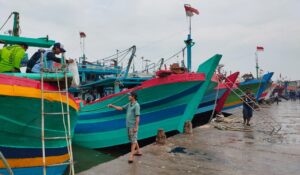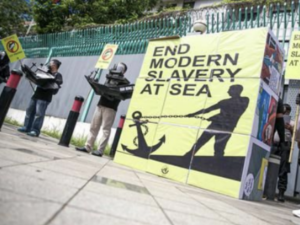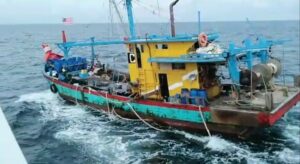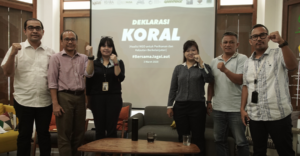
The Minister of Marine Affairs and Fisheries, Sakti Wahyu Trenggono, has officially issued a regulation regarding the prohibition of fishing gear that can damage the environment, and trawl (cantrang) is one of them, as stated in the Regulation of the Minister of Maritime Affairs and Fisheries (Permen KP) Number 18 of 2021 concerning the Placement of Fishing Equipment and Fishing Aids in the Fisheries Management Area of the Republic of Indonesia and the High Seas. According to the Director-General of Capture Fisheries, M. Zaini, this regulation is meant to elaborate on and revise the Ministerial Regulation No. 26 of 2014 concerning FADs, Ministerial Regulation No. 25 of 2020 concerning Fishing Maintenance, Ministerial Regulation No. 59 of 2020 concerning Fishing Paths and Fishing Equipment, as well as the Decree of the Minister of Marine Affairs and Fisheries Number 6 of 2020 concerning Fishing Equipment in Indonesia’s FMAs.
This policy also summarizes the allowed fishing gear, one of which is bagged fishing nets and ballast. However, this gear is still suspected to be harmful to the environment, since the presence of ballast in the bagged net will make the net sink and most likely touch the seabed. Similar to trawls, when the bagged net is pulled, the net will “sweep” the contents of the seabed and cause damage, especially if the net diameter is tight. As a result, this can lead to indiscriminate fishing and the transport of small and large coral reefs. Even if the diameter of the net is not too tight, when the net is pulled at high speed, medium-sized fish and biodiversity may also get caught in the net.
It should be noted that trawls and bagged draw nets are both in the form of nets, but the difference is that the meshes on trawls are diamond-shaped (diamond mesh) while the meshes in all parts of the draw-net are square. Trawls, otherwise known as the Danish Seine Net, is a variant of the type of seine net or Pukat Tarik. Trawls consist of a conical net, two wings, and a rope with an average length of 800-1,000 meters to encircle the fishing area and an anchored buoy with a swept area of about 800 meters. The length of the trawl rope and the catchment area of the trawl net make it destructive to coral reefs and attract all sizes of fish and types of resources.
The new regulation that allows the use of bagged pull nets will be permitted to operate in the Republic of Indonesia Fisheries Management Area (WPP RI) 711, or the area between the Riau Archipelago Sea and the Natuna Sea in a zone above 30 miles and FMA 712, or the North Sea of Java Island. Susan Herawati, Secretary-General of the People’s Coalition for Fisheries (KIARA) has questioned and criticized this new regulation. She has voiced several concerns: whether or not the government has prepared and completed the regulation with a transition scheme and its implementation; the fact that the latest Ministerial Regulations actually ignore the facts and findings of the KKP itself which were published in 2018 in the Marine and Coastal Resources Statistics document which states that non-environmentally friendly fishing causes ineffective and exploitative fishing, destroys coral reefs, and triggers conflict socio-economic conditions at the grassroots; and the fact that this bagged net fishing gear works in the same way as trawls and still risks damaging marine resources.
Meanwhile, the National Coordinator of Destructive Fishing Watch (DFW) Indonesia, Muhammad Abdi Suhufan, said that this new regulation did not bring significant changes in terms of sustainability. In line with Susan, the essence of how fishing gear works and the same fishing area actually seems to allow destructive fishing gears to be used.
Although the Director-General of Capture Fisheries M. Zaini said that this policy will only apply to previously registered trawl vessels and will not add new permits, the policy of replacing trawls still needs to be reassessed. It is true that improving the quality of income and the economy of fishers must be considered, but in the future, there will be no longer available healthy marine biodiversity for fishers to reap marine products if destructive fishing gears can still be used. First and foremost, the use of bagged net fishing gear and ballast must be regulated thoroughly and firmly. These regulations include the size and materials used must be adapted to the fishing area. Nets and ballast materials are important because if the materials used are at risk of harming uncaught fish or damaging coral reefs, the consequences on the environment will be just as severe.
Different features of FMAs, with different currents, seabed morphology, et cetera, can dictate whether fishing nets will work well and are environmentally friendly or not. In addition, each FMA has its own criteria for its fish population, and the personalization of this fishing net can be used as a way to select catches according to the criteria for fish in that area. Ballast equipment must also be regulated by the KKP because it will affect how deep the net will sink.
In addition to regulations regarding fishing gears, regulations and legal instruments, as well as supervision, must also be improved from the grassroots level. This means improving the strictness of supervision in granting permits to operate vessels with bagged towing nets and ballast which are only given to former trawl vessels, meaning that the number of vessels, as well as fishers or shipowners of this type, should not suddenly increase. Proper training and socialization must also be provided to fishers before this regulation is implemented. In addition, the supervision of the KKP must be carried out periodically to ensure compliance in the field. Legal instruments such as fines and criminal penalties must also be enforced because these violations are included in the realm of illegal, unregulated, unreported fishing (IUUF).
******





